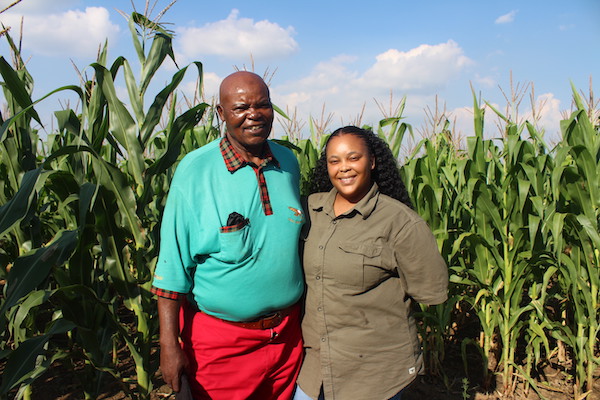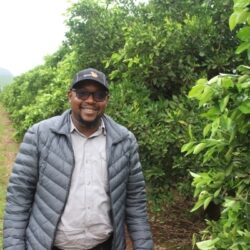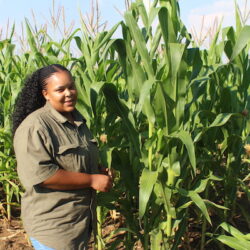From when she was in high school, Keneilwe Raphesu started shadowing her father, Dr Mamabolo Raphesu, on his farm. Two years ago, she came out from his shadow to swop life in academia for life on a farm. Peter Mashala caught up with this ambitious father-and-daughter team.
As a young black woman, many people were sceptical that 24-year- old Keneilwe Raphesu had what it takes to assume control of her father’s 405ha enterprise
in Holfontein. Yet the trust, knowledge and support from her dad – along with impressive skills acquired through the Sernick Emerging Farmers Programme – gave Keneilwe the tools to take the farming operation to new heights.
Keneilwe was handed the reins of the cattle, pig and grain farm in 2020 when her dad, Dr Mamabolo Raphesu, resigned to focus on his political career.
“I started getting more involved on the farm from 2018 when I was studying my first degree in economics and international trade. My dad gave me the full reins and made me a director in the business in 2020,” says Keneilwe, who graduated in 2019 and is now in the final year of her second degree.
Mamabolo had been farming for about 18 years on this leased government farm in Holfontein, near Vanderbijlpark, on the border of Gauteng and North West province.
“When I decided to pursue my political work full time, I handed the farm over to Keneilwe. She had been shadowing me since she was in high school and I had confidence in her,” recalls Mamabolo, who works at the local municipal council of Emfuleni in Vanderbijlpark in the Sedibeng municipality.
Mamabolo began his farming career in the late 1990s on communal land outside Sharpeville with two friends. In 2003, the three acquired a 200ha farm near Meyerton, outside Vereeniging, where they kept about 60 cattle. Mamabolo then applied for his own farm through government’s Proactive Land Acqui sition Strategy (PLAS).
“The farm had over 200ha arable land, but I was not really interested in crop farming because I had no experience or equipment,” says Mamabolo, a Limpopo native from GaMokgopo and a former lecturer at the University of Limpopo (Turfloop).
Keneilwe runs a small piggery of 20 sows and a boar. This provides handy cash flow.
Keneilwe has transformed 80% of the herd to Bonsmaras with the help of the Sernick Emerging Farmers Programme. This taught her a great deal about animal production and evaluating body condition using the “hands-on” method.
A FARMING FAMILY
Keneilwe spent most of her time with her dad growing up.
“When I was still in high school, I would tail him everywhere: working on the farm, doing vaccinations and inoculations, attending auctions. I used to travel with him to the Free State where he bought his bulls. It didn’t make sense to me at the time to spend so much money on a bull,” she recalls.
It makes perfect sense now, after her training at Sernick. “I fully understand why dad spent money on quality bulls. We buy stud bulls from reputable farmers. Our latest is a threeyearold Bonsmara bull from Nick Serfontein of Sernick Bonsmaras.”
A bull contributes about half the genes to his progeny, so beef producers should not compromise on quality, she says.
“One should always go for a bull with good conformation to ensure you produce heavier weaners, which will fetch good prices at auctions. That’s why I convinced my dad to transform our herd from mixed breeds of Bradford, Charolais, Simbra and Brahman to one breed with the best traits,” explains Keneilwe.
Their breed of choice was Bonsmara, inspired by Keneilwe’s experience with this breed during her training at Sernick. When she stepped into her dad’s shoes, their herd consisted of about 55 mixedbreed cattle. She has transformed it into 80% Bonsmara, with 39 breeding Bonsmara cows and one bull.
Most of the older cows were replaced with 18monthold Bonsmara heifers with a smaller frame and body weight. “As for the bull, I chose one that wasn’t too muscular because I didn’t want a bull that would struggle during mating,” explains Keneilwe.
Her aim is to produce cattle with more muscle than fat, so she does not pamper them with supplementary feed. Instead, she employs a semiintensive feeding programme.
“We have good grazing that is dominated by sweet grass, so in summer we only provide cattle with summer licks,” she says.
In winter, they get supplementary feed of molasses and yellow maize twice a day, as well as a winter lick. Keneilwe also provides Smuts finger hay bales.
“Most of the cows are pregnant now and therefore we must provide enough protein, vitamins and trace minerals to maintain good body condition for delivering healthy calves and to help them produce sufficient milk to raise them.”
100% CALVING RATE
Keneilwe has two breeding seasons. From November to January, half the cows are run with the bull in one camp. “Because of our good annual rainfall, averaging between 600mm and 700mm, we generally have enough grass in our four camps of 13ha, 17ha, 60ha and 100ha,” explains Keneilwe.
Pregnancy tests are performed in February. Cows that have not conceived are put with the bull for the second mating in April to May. Pregnant cows are separated from those that didn’t conceive at either mating.
“It’s important to conduct fertility and trichomoniasis disease tests on the bull before it’s put in with cows for mating. The bull is responsible for 50% of your production, so looking after it is important.”
The bull is always on a bull finisher or production lick containing natural protein, non-protein nitrogen (NPN) compounds, carbohydrates and other trace minerals. Their conception rate is close to 95%. The calving rate is 100%, with extremely low mortality.
“Calving occurs from August to September with the first batch, and from December with the second batch,” she says, adding that mating and calving seasons are timed to coincide with periods of sufficient grazing.
Calves are weaned at six to eight months at a weight of 190-220kg.
“Male weaners are sold on auction or to an abattoir in Holfontein. All female weaners are kept and raised for breeding.”
MIXED FARMING
Although Mamabolo wasn’t initially too keen on crop farming, they had to utilise the 205ha arable lands to make the operation viable. They first rented out the fields to a commercial farmer for maize and soya bean production.
They capitalised on the opportunity to buy their own equipment with the rental income, and started to practice what they learnt on their own smaller plots.
They’ve now resumed control of 116ha: 90ha maize and 26ha soya beans. Soil preparations began in October, with planting taking place from late October to November. However, the rains caught up with them and they couldn’t finish planting the entire area.
To help with cashflow, they also run a small piggery with eight sows and a boar. The piglets are sold to an abattoir and to the public from six to 10 weeks old, at about 25kg. Keneilwe plans to expand the piggery to over 50 breeding sows, while her five-year goal is to acquire more land to grow the cattle operation and increase the herd.
With farming in her family, and a head full of knowledge, the opportunities are limitless for Keneilwe.
“I dream of establishing a feedlot, of opening an abattoir and butchery someday … and maybe becoming an auctioneer too! Who knows,” she laughs.
The herd has a 95% conception rate and 100% calving rate. Calves are weaned at six to eight months, between 190kg and 220kg.
UPSKILLING FOR COMMERCIAL SUCCESS
Keneilwe completed the 18month Sernick Emerging Farmers Programme at the Sernick Group’s farm in Edenville outside Kroonstad, Free State.
The Sernick Group runs this programme in partnership with the Jobs Fund at National Treasury, and aims to develop emerging cattle farmers into profitable commercial cattle farmers. It focuses on animal production – from animal health and nutrition to animal selection, feed lotting and veld management.
It also includes business courses, such as marketing and financial management. The farmers receive SETAaccredited training and an opportunity to exchange their old stock with goodquality cattle that fetch higher prices.
“I’ve been part of the Tier 2 group where the emphasis is on herd development and maintaining a healthy cash flow,” explains Keneilwe.
Keneilwe has transformed her dad’s herd from 55 mixedbreeds to 80% Bonsmara, with 39 breeding Bonsmara cows and one bull.
“I go by the motto ‘quality over quantity’. Maintaining good genetics and achieving high performance and productivity from the bull and the cows is paramount.”
Keneilwe’s immediate goal is to become part of the Tier 3 group in the Sernick programme. “This will not only improve my skills but will help us acquire more breeding stock. When you reach Tier 3, you qualify for a loan made up of 35 breeding cows and a bull.”




